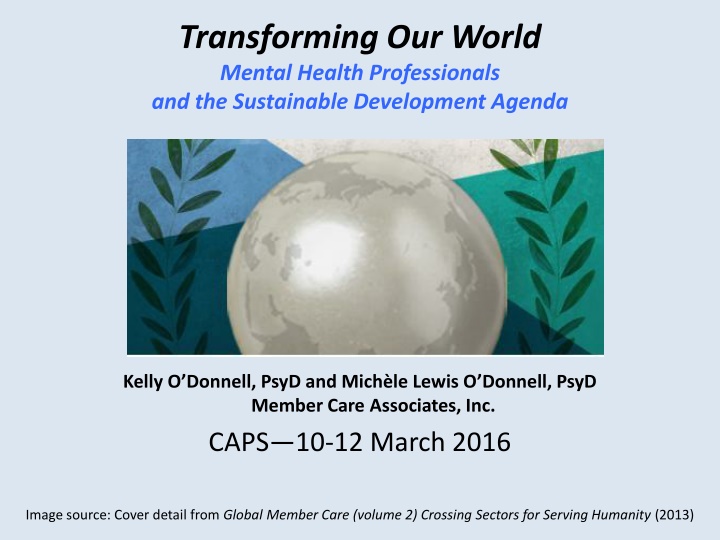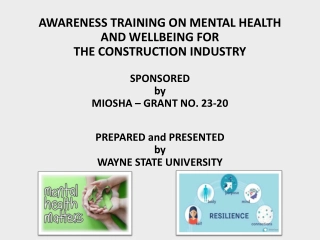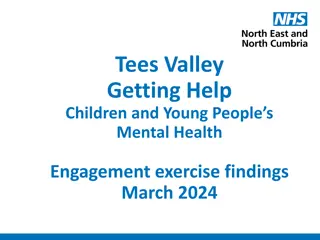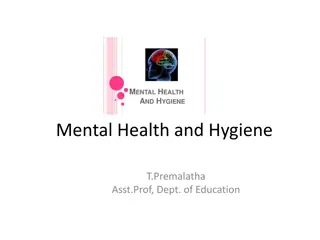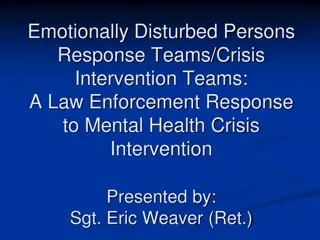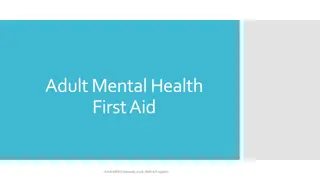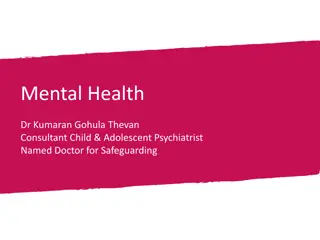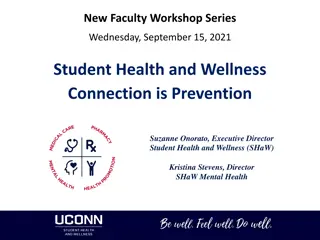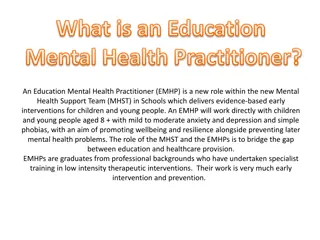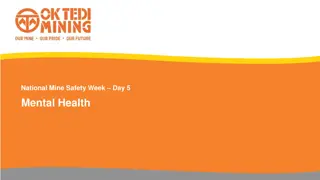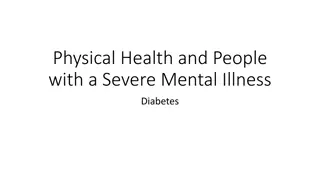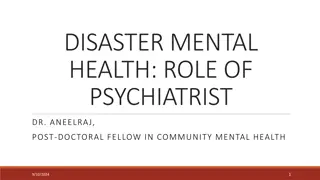Mental Health Professionals and Sustainable Development
Mental health professionals with faith-based values can connect globally to address major challenges in alignment with the UN's Sustainable Development Agenda and WHO's Mental Health Action Plan. Learn about global integration, key frameworks, and practical examples in Lebanon and Ethiopia.
Download Presentation

Please find below an Image/Link to download the presentation.
The content on the website is provided AS IS for your information and personal use only. It may not be sold, licensed, or shared on other websites without obtaining consent from the author.If you encounter any issues during the download, it is possible that the publisher has removed the file from their server.
You are allowed to download the files provided on this website for personal or commercial use, subject to the condition that they are used lawfully. All files are the property of their respective owners.
The content on the website is provided AS IS for your information and personal use only. It may not be sold, licensed, or shared on other websites without obtaining consent from the author.
E N D
Presentation Transcript
Transforming Our World Mental Health Professionals and the Sustainable Development Agenda Kelly O Donnell, PsyD and Mich le Lewis O Donnell, PsyD Member Care Associates, Inc. Kelly O Donnell, PsyD and Mich le Lewis O Donnell, PsyD Member Care Associates, Inc. CAPS 10-12 March 2016 Image source: Cover detail from Global Member Care (volume 2) Crossing Sectors for Serving Humanity (2013)
Purpose How can MHPs with faith-based values connect and contribute with our globalizing world and its major challenges, and do so in view of the UN s 2030 Sustainable Development Agenda and WHO s Mental Health Action Plan 2013-2020?
Presentation Overview --Global Integration --UN Sustainable Development Agenda --WHO MH Action Plan Part 1: Global Frameworks Reports on global issues to inform you (e.g., WB development, IFRC disasters, GPP peacebuilding) Part 2: Global Context Resources to support your work (e.g., newsletters, publications, training) Part 3: Global Mental Health Interests, involvements, influences Part 4: Strategies for Crossing Sectors
Three Learning Objectives 1. List 3 SDGs relevant for MH 2. Describe the 4 objectives in the MH-Action Plan 3. List 3 resources to help you connect-contribute globally as a MHP
Part One Global Frameworks GI SDGs MH-AP
Globalntegration A framework for: actively integrating our lives with global realities by connecting relationally and contributing relevantly on behalf of human wellbeing and the issues facing humanity, in light of our integrity and core values (e.g., ethical, humanitarian, faith-based) ad majorem Dei gloriam.
Three Personal Examples of GI Lebanon and Ethiopia --as learners-practitioners shadowing social workers --as consultants-therapists supporting Christian workers Geneva as MH advocates-trainers attending UN and INGO events Virtual as resource links via the GI Updates
Lebanon Visiting newly arrived refugees A makeshift refugee camp in the Becca Valley Lines for school registration in a new TM camp
Evangelicals a Liberal Can Love "In parts of Africa where bandits and warlords shoot or rape anything that moves, you often find that the only groups still operating are Doctors Without Borders and religious aid workers: crazy doctors and crazy Christians. In the town of Rutshuru in war-ravaged Congo, I found starving children, raped widows and shellshocked survivors. And there was a determined Catholic nun from Poland, serenely running a church clinic. Unlike the religious right windbags, she was passionately pro-life even for those already born and brave souls like her are increasingly representative of religious conservatives. We can disagree sharply with their politics, but to mock them underscores our own ignorance and prejudice. Evangelicals a Liberal Can Love. Nicholas Kristof, New York Times (February 3, 2008) See also: Some Myths about Faith-Based Humanitarian Aid. Wilfred Mlay, Humanitarian Exchange 27(July 2004, pp. 48-51)
Ethiopia Delivering Hope International Doulas working in their neighborhood a slum beside a landfill reaching out with compassion & support to improve maternal, newborn and child health, and promote family preservation and the prevention of orphans.
UN Year in Review 2015 2015--In another year of extraordinary challenges for the world community, the United Nations turned 70--A time to look back at its founding document, the Charter--and to create a new vision of a future in peace and dignity. http://webtv.un.org/watch/year-in-review- 2015-short-version/4670505629001
. GI Update December 2015 http://membercareassociates.org/?page_id=726 Staying Current Navigating the News Things We Need to Know
Global Mental Health Evidence-Based Practice in Low Resource Countries October 2013, Geneva WHO Collaborating Centre on Mental Health of the University of Geneva, Department of Psychiatry
Johns Hopkins UPaul Bolton, Laura Murray, Judy Bass EBP in Low Resource Countries, October 2013
World Health Organisation, Geneva, mhGAP Forum 2015
MH and Dignity ,at World Council of Churches, organized by NGO Forum for Health, Sept. 2014 lots of folks, including Gabriel Ivbijaro (current President of WFMH) .
MH and Dignity ,at World Council of Churches, organized by NGO Forum for Health, Sept. 2014 lots of folks, including Gabriel Ivbijaro (current President of WFMH) .
Committee on Mental Health, CoNGO Integrating Physical and Mental Health for SD, NY UN Church House,
NIMH and Grand Challenges Canada et al. Wietze Tol and Vikram Patel .
Trio Gathering Leadership in an Age of Turmoil https://sites.google.com/site/virtrios/ O Donnells house in France March 2015
Video overview-promo: http://webtv.un.org/watch/adoption-of-the-sustainable-development-goals/4513425361001 .
Transforming Our World: The 2030 Agenda for Sustainable Development United Nations, 25 September 2015, paragraph 50 "Today we are also taking a decision of great historic significance. We resolve to build a better future for all people, including the millions who have been denied the chance to lead decent, dignified and rewarding lives and to achieve their full human potential. We can be the first generation to succeed in ending poverty; just as we may be the last to have a chance of saving the planet "
SDGs Goal 1 End poverty in all its forms everywhere Goal 2 End hunger, achieve food security and improved nutrition and promote sustainable agriculture Goal 3 Ensure healthy lives and promote well-being for all at all ages Goal 4 Ensure inclusive and equitable quality education and promote lifelong learning opportunities for all Goal 5 Achieve gender equality and empower all women and girls Goal 6 Ensure availability and sustainable management of water and sanitation for all Goal 7 Ensure access to affordable, reliable, sustainable and modern energy for all Goal 8 Promote sustained, inclusive and sustainable economic growth, full and productive employment and decent work for all Goal 9 Build resilient infrastructure, promote inclusive and sustainable industrialization and foster innovation Goal 10 Reduce inequality within and among countries Goal 11 Make cities and human settlements inclusive, safe, resilient and sustainable Goal 12 Ensure sustainable consumption and production patterns Goal 13 Take urgent action to combat climate change and its impacts Goal 14 Conserve and sustainably use the oceans, seas and marine resources for sustainable development Goal 15 Protect, restore and promote sustainable use of terrestrial ecosystems, sustainably manage forests, combat desertification, and halt and reverse land degradation and halt biodiversity loss Goal 16 Promote peaceful and inclusive societies for sustainable development, provide access to justice for all and build effective, accountable and inclusive institutions at all levels Goal 17 Strengthen the means of implementation and revitalize the global partnership for sustainable development
. According to the World Health Organization (WHO), mental, neurological, and substance use disorders are common in all regions of the world, affecting every community and age group across all income countries. While 14% of the global burden of disease is attributed to these disorders, most of the people affected 75% in many low-income countries do not have access to the treatment they need. (WHO, 2008, launch of the mhGAP program) http://www.who.int/mental_health/mhgap/en/index.html WHO estimates: 25 million have schizophrenia 50 million have epilepsy over 100 million have drug or alcohol use disorders over 150 million have depression over 800 thousand suicides/year. In addition, people with these disorders are often subjected to social isolation, poor quality of life and increased mortality. These disorders are the cause of staggering economic and social costs. (WHO Department of Mental Health, The Bare Facts).
Overview: Mental Health Action Plan 2013-2020 Vision A world in which mental health is valued, promoted, and protected, mental disorders are prevented and persons affected by these disorders are able to exercise the full range of human rights and to access high-quality, culturally appropriate health and social care in a timely way to promote recovery, all in order to attain the highest possible level of health and participate fully in society and at work free from stigmatization and discrimination. Cross-cutting Principles Universal health coverage Human rights Evidence-based practice Life course approach Multisectoral approach Empowerment of persons with mental disorders and psychosocial disabilities Regardless of age, sex, socioeconomic status, race, ethnicity or sexual orientation, and following the principle of equity, persons with mental disorders should be able to access, without the risk of impoverishing themselves, essential health and social services that enable them to achieve recovery and the highest attainable standard of health. Mental health strategies, actions and interventions for treatment, prevention and promotion must be compliant with the Convention on the Rights of Persons with Disabilities and other international and regional human rights instruments. Mental health strategies and interventions for treatment, prevention and promotion need to be based on scientific evidence and/or best practice, taking cultural considerations into account. Policies, plans, and services for mental health need to take account of health and social needs at all stages of the life course, including infancy, childhood, adolescence, adulthood and older age. A comprehensive and coordinated response for mental health requires partnership with multiple public sectors such as health, education, employment, judicial, housing, social and other relevant sectors as well as the private sector, as appropriate to the country situation. Persons with mental disorders and psychosocial disabilities should be empowered and involved in mental health advocacy, policy, planning, legislation, service provision, monitoring, research and evaluation. Goal To promote mental well-being, prevent mental disorders, provide care, enhance recovery, promote human rights and reduce the mortality, morbidity and disability for persons with mental disorders Objectives and Targets 1. To strengthen effective leadership and governance for mental health 2. To provide comprehensive, integrated and responsive mental health and social care services in community-based settings 4. To strengthen information systems, evidence and research for mental health 3. To implement strategies for promotion and prevention in mental health Global target 3.1: 80% of countries will have at least two functioning national, multisectoral mental health promotion and prevention programmes (by the year 2020). Global target 1.1: 80% of countries will have developed or updated their policy/plan for mental health in line with international and regional human rights instruments (by the year 2020). Global target 4: 80% of countries will be routinely collecting and reporting at least a core set of mental health indicators every two years through their national health and social information systems (by the year 2020). Global target 2: Service coverage for severe mental disorders will have increased by 20% (by the year 2020). Global target 3.2: The rate of suicide in countries will be reduced by 10% (by the year 2020). Global target 1.2: 50% of countries will have developed or updated their law for mental health in line with international and regional human rights instruments (by the year 2020).
SUNDAR (example of MH Action Plan, Objective 2) Vikram Patel Simplify message UNpack treatments (core components) Deliver where people are Affordable and available human resources Reallocation of specialists
Part Two Global Context World Development Report: Mind, Society, and Behavior World Bank (2015) Disasters Report: Focus on Culture and Risk International Federation of Red Cross and Red Crescent Societies (2014) White Paper on Peacebuilding Geneva Peacebuilding Platform (2015)
World Development Report: Mind, Society, and Behavior World Bank (2015) The Report aims to integrate recent findings on the psychological and social underpinnings of behavior to make them available for more systematic use by both researchers and practitioners in development communities. The Report draws on findings from many disciplines, including neuroscience, cognitive science, psychology, behavioral economics, sociology, political science, and anthropology. In ongoing research, these findings help explain decisions that individuals make in many aspects of development, including savings, investment, energy consumption, health, and child rearing. The findings also enhance the understanding of how collective behaviors such as widespread trust or widespread corruption develop and become entrenched in a society. The findings apply not only to individuals in developing countries but also to development professionals, who are themselves prone to error when decision-making contexts are complex. (pp. 2-3)
Disasters Report: Focus on Culture and Risk International Federation of Red Cross and Red Crescent Societies (2014) This year, the World Disasters Report takes on a challenging theme that looks at different aspects of how culture affects disaster risk reduction (DRR) and how disasters and risk influence culture. The report asks, for example, what should be done when people blame a flood on an angry goddess (River Kosi, India, in 2008) or a volcanic eruption on the mountain god (Mount Merapi). After the tsunami in 2004, many people in Aceh (Indonesia) believed that Allah had punished them for allowing tourism or drilling for oil, and similar beliefs were widespread in the United States regarding Hurricane Katrina, showing God s displeasure with aspects of the behaviour of the people who live in or visit New Orleans. ; Most people who live in places that are exposed to serious hazards are aware of the risks they face, including earthquakes, tropical cyclones, tsunami, volcanic eruptions, floods, landslides and droughts. Yet they still live there because, to earn their living, they need to or have no alternative. Coasts and rivers are good for fishing and farming; valley and volcanic soils are very fertile; drought alternates with good farming or herding. Culture and beliefs, for example, in spirits or gods, or simple fatalism, enable people to live with risks and make sense of their lives in dangerous places. Sometimes, though, unequal power relations are also part of culture, and those who have little influence must inevitably cope with threatening environments. .Sometimes there is also an institutional reluctance to deal with the issues of inequality and power that make people vulnerable in the places where they make a living. The one thing that is certain is that we will have less sustained impact if we do not adequately take account of people s cultures, beliefs and attitudes in relation to risk (P.8)
White Paper on Peacebuilding Geneva Peacebuilding Platform (2015) TheWhite Paper reflects a 12-month collaborative multi-stakeholder initiative with [100+] peacebuilding professionals from all regions coordinated by the Geneva Peacebuilding Platform. The aim of this exercise is [to broaden] the discussion about how countries and societies can move towards sustainable peace, and about the assistance the UN and other international and local actors can bring to such processes. peace (Geneva Peacebuilding Platform website) Why is such a broader conversation necessary? First, the next decade will see more pressures on states and societies and likely more conflict. These pressures can emerge, for instance, from demographic trends (population growth, increasing urbanization), economic trends (more inequality and unemployment), power shifts (changing constellations, diffusion of power, less control by states), climate change (more natural disasters and climatic fluctuations) and new conflict dynamics (geo-political tension, more chronic violence, new threats).2 Rising pressures will likely increase the risk of conflict. In some regions, this conflict could be violent. In order to face these challenges, peacebuilding and prevention capacities need to be developed further and rendered more effective. (p. 6) The findings are presented in four sections: The global context of the peacebuilding field Challenges for peacebuilding practice Opportunities for peacebuilding practice Future perspectives for building
Part Three Global Mental Health Newsletters Training Texts-Journals
Global Mental Health "GMH interdisciplinary, promotes human well-being, the right to health, and equity in health for all. It encourages healthy behaviours and lifestyles; is committed to preventing and treating mental, neurological, and substance use conditions; and seeks to improve policies and programs, professional practices and research, advocacy and awareness, and social and environmental factors that affect health and well- being. Based on definition from: GMH--Finding Your Niches and Networks, Psychology International, March 2012 is an international, and multi-sectoral culturally-sensitive, domain which
Hidden Pictures A Personal Journey into GMH (trailer of the film by Delaney Ruston, MD) https://www.youtube.com/watch?v=Y8Tbiciyzq0
Convention on the Rights of Persons with Disabilities (UN, 2006) The purpose of the present Convention is to promote, protect and ensure the full and equal enjoyment of all human rights and fundamental freedoms by all persons with disabilities, and to promote respect for their inherent dignity. Article 1 - Purpose Persons with disabilities include those who have long-term physical, mental, intellectual or sensory impairments which in interaction with various barriers may hinder their full and effective participation in society on an equal basis with others.
GMH-Map a global map for a global movement https://sites.google.com/site/gmhmap/
GMH: Newsletters-Updates Mental Health Innovation Network (monthly) Movement for Global Mental Health (monthly) mhGAP, World Health Organization (twice a year) Bulletin, World Federation for Mental Health (quarterly) Psychology International, Office of International Affairs, American Psychological Association (4-6 times/year). Also as of April 2015 there is a biweekly news bulletin with information about opportunities for international involvement in mental health. Gulbenkian Global Mental Health Platform (monthly) See more here: https://sites.google.com/site/gmhmap/home/gmh- updates
GMH Training Doctoral Programs Chicago School of Professional Psychology, International Psychology, online with concentrations in Organizations/Systems or Trauma Services. Masters Programs MSc Global Mental Health, London-based course taught jointly between the London School of Hygiene and Tropical Medicine and King's College London Institute of Psychiatry. Click here for the online prospectus. MSc Global Mental Health: University of Glasgow, College of Medical, Veterinary, and Life Sciences. Click here for theprogramme brochure. International Masters in Mental Health Policies and Services, Universidade Nova de Lisboa, Faculdade de Ci ncias M dicas.Click here for the program brochure. Master of Arts in Counseling Psychology and Global Mental Health: William James College (formerly Massachusetts School of Professional Psychology). Click here for the program brochure. Courses GMH: Trauma and Recovery Certificate Program, Harvard Program in Refugee Trauma (on-site learning in Italy, and web-based learning). Certificates of completion are awarded by HPRT and the Harvard Medical School Department of Continuing Education. Leadership in Mental Health Course, Sangath Centre and London School of Hygiene and Tropical Medicine(Goa, India). See more here: https://sites.google.com/site/gmhmap/home/gmh-training-programmes
GMH Texts and Journals Texts Global Mental Health: Trauma and Recovery (2011, edited by Richard Mollica) 21stCentury Global Mental Health (2012, edited by Eliot Sorel) Global Mental Health: Principles and Practice (2013, edited by Vikram Patel et al.) Journals Global Mental Health (open access journal on GMH, first issue in 2014) Transcultural Psychiatry (December 2014); special issue on GMH The Lancet (October 2011 and September 2007); special issues on GMH See more here: https://sites.google.com/site/gmhmap/home/gmh-texts- journals
Part Four Strategies for Crossing Sectors Interests Involvements Influences
Sectors Specialized groupings of people that provide different types of services and products to people. Each sector is comprised of a wide array of people who are part of different organizations; influenced disciplines, practices, intertwined with many related networks. A sector fundamentally, is a human entity. by goals; various and and Crossing Sectors for Serving Humanity, pp. 5-6
Relevance The relevance of crossing sectors is seen in the research by Johnson et al (2010) which advocates for greater interactions between the major religious blocs, especially Christians and non-Christians, in the service of humanity. What percentage of non-Christians personally know a Christian? The [research] results are startling in the sense that Christians and non-Christians appear to be living in quite separate worlds. This distance has implications for Christian missions but is also problematic when it comes to dialogue, peace initiatives, environmental and health challenges, and many other areas of human interaction. Our hope is that highlighting the problem will help in planning solutions for the future. (p.29) Crossing Sectors, pp. 9-10
5 Applications Crossing Sectors for Serving Humanity Support mission/aid workers in their well-being and effectiveness Support colleagues in other sectors via materials in the member care field Equip mission/aid workers with tools and opportunities for their work with others Equip member caregivers who directly work with vulnerable populations and others Stay informed as global citizens about current and crucial issues facing humanity
Field Consults Practicalities and Tools See Member Care Update December 2015 Field Consults: Risk--Resilience--Relevance Relationships http://us4.campaign-archive1.com/?u=f34fc856e7776d7b69dafd3b3&id=8c9091153a
Crossing sectors: Issues Pursue your passions --What issues matter to you the most? --What are you passionate about? --What are you motivated to learn more about?
Crossing sectors: Involvements Till the terrain --What types and levels of involvement are realistic for you? --With whom? --How to sustain your involvements? Continuum of Involvement Informed----------Included----------Immersed
